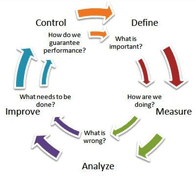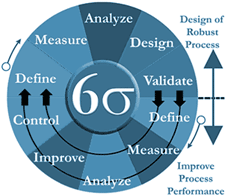Services /
Six Sigma /MethodsSix Sigma projects follow two project methodologies, composed of five phases each, bear the acronyms DMAIC and DMADV.
- DMAIC is used for projects aimed at improving an existing business process. DMAIC is pronounced as "duh-may-ick".
- DMADV is used for projects aimed at creating new product or process designs. DMADV is pronounced as "duh-mad-vee".
DMAIC
The DMAIC project methodology has five phases:

- Define the problem, the voice of the customer, and the project goals, specifically.
- Measure key aspects of the current process and collect relevant data.
- Analyze the data to investigate and verify cause-and-effect relationships. Determine what the relationships are, and attempt to ensure that all factors have been considered. Seek out root cause of the defect under investigation.
- Improve or optimize the current process based upon data analysis using techniques such as design of experiments, poka yoke or mistake proofing, and standard work to create a new, future state process. Set up pilot runs to establish process capability.
- Control the future state process to ensure that any deviations from target are corrected before they result in defects. Control systems are implemented such as statistical process control, production boards, and visual workplaces and the process is continuously monitored.
DMADV
The DMADV project methodology, also known as DFSS ("Design For Six Sigma") features five phases:

- Define design goals that are consistent with customer demands and the enterprise strategy.
- Measure and identify CTQs (characteristics that are Critical To Quality), product capabilities, production process capability, and risks.
- Analyze to develop and design alternatives, create a high-level design and evaluate design capability to select the best design.
- Design details, optimize the design, and plan for design verification. This phase may require simulations.
- Verify the design, set up pilot runs, implement the production process and hand it over to the process owner(s).